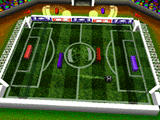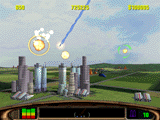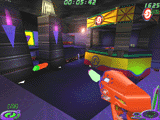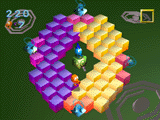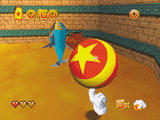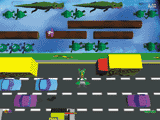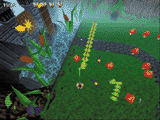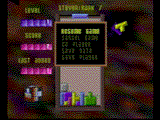by Brian Rittmeyer
They can't remember the once mighty empire that brought video games
home in the late 1970s and early 1980s with the 2600 Video Computer
System. And as far as they're concerned, there are only two Jaguars
-- the cat and the ones that have four wheels. Pushed aside by the
likes of Nintendo, Sega, Sony and personal computers with 3D
acceleration, Atari's early days are ancient history; its later days
known only to loyalists and, much like David Hasselhoff's music career,
more successful outside America. But then something funny happened.
Perhaps spurred the most by those in their late 20s and early 30s, a
new phenomenon emerged -- "classic" or "retro" gaming.
Is it a fad, a trend or is it here to stay? Such questions over the
phenomenon weren't enough to dissuade Hasbro Interactive from picking
up Atari's bruised and battered remains, along with the rights to 75
classic titles, for a cool $5 million from hard drive maker JTS Corp.
in March 1998.
"Atari has been irrelevant in the gaming industry, but Hasbro is going
to change that," said Jayson Hill, manager of public relations for
Hasbro Interactive in Beverly, Mass.
The significance of Hasbro Interactive's purchase of Atari might be
compared to finding a rare 2600 cartridge at a yard sale -- it might be
worth hundreds to the collector who knows what it is, but it's only
worth a buck or two to the dealer. While most of the public might have
taken the news as unremarkable, or maybe even forgettable, it was
mindboggling to Atarians, including John Hardie, 34, of Valley Stream,
N.Y. "That should go down as the steal of the century," said Hardie,
a cable splicer for Bell Atlantic who helped organize the recent Classic
Gaming Expo in Las Vegas and has a hand in running the Atari Gaming
Headquarters Web site. "The users could've gotten $5 million together
and bought it themselves."
But why would anyone be interested in buying the rights to a forgotten
company that the public would have to be sold on all over again? For
starters, Hill said Hasbro Interactive bought Atari because JTS offered
it to them. "We figured the name still had a lot of equity in it, even
if not much had been done with it in a while," Hill said. "There was a
wonderful catalogue of games." And further, "We believe that retro-gaming
is here to stay."
But Hasbro wasn't the only potential buyer. Don Thomas of Manteca, Calif.,
a well-known Atari employee from 1989 to 1995, said he had suggested
buying Atari to, of all companies, Sony. "For a number of reasons, Sony
had no interest in that area," said Thomas, 41, now in charge of peripheral
licensing for NUON at VM Labs. "Sure enough, not too long afterwards, it
was announced Hasbro had acquired it for $5 million." There were still
more potential buyers, but Thomas, lacking first-hand knowledge, declined
to reveal all that he knows. "I think the fans of Atari, whether they
know it or not, are best served by Hasbro," he said. "It's easy to forget
there has to be a business model to keep the brand going. Hasbro has the
right model."
But not all Atari fans would agree. For those like 19-year-old Fard Muhammad
of Chicago, Atari can not be said to be saved unless its name appears on
hardware as well as software. While Hasbro may have saved Atari from
oblivion, the company "has downgraded Atari from the company that it once
was to a third party company slugging out old games for new systems,"
Muhammad said. "Hasbro is changing the Atari name from an American
institution to a retro-gaming marketing gimmick and unless something is
done about it soon, it will stay that way forever."
Hasbro Interactive intends to release both updated classics and new
titles with the Atari name, but all will follow the Atari philosophy
of "five minutes to learn and forever to master." "The secret is still
simple, addictive game play," Hill said. "If you can't play it in five
minutes it's not an Atari title. That's the rule." The interest in the
older games is due to several reasons, Hill said, such as the feeling
that current games lack originality and are too complex. "It's gotten
to where you can't sit down, play a 20 minute game, get up and go on
with life. You have to invest hundreds of hours of play," he said. "I
think some people long for a time when they could relieve a little
stress over a half hour and go on with their lives." To date, the Atari
name has appeared on classic titles such as Frogger and
Centipede and on a collection of
Atari Arcade Hits. A new game, Glover,
carries the fuji logo.
While industry reaction has been mixed, Hill said Centipede was received
favorably by the general public. Hardie said he has been "thrilled" with
the company's efforts so far. "I thought Centipede was really good," he
said, adding that Frogger wasn't bad for the first attempt either. "Many
gamers weren't crazy about it. I really enjoyed the first-person mode and
the adventure mode." Still, an improved version of Centipede is planned
for Sega's new console, the Dreamcast. "It's significantly improved over
the IBM-PC and Playstation version," Hill said. Four more titles are due
for release this fall. Three are updates -- Pong,
Missile Command and Q*Bert -- while one is a
new title that clearly shows Atari's link to Hasbro, Nerf Arena Blast.
Hill described Nerf Arena Blast as a first person shooting game that,
instead of guns and rockets like Doom, uses Nerf weapons. Nobody dies
in the game, perhaps a response to recent public outcry over violent
video games. Four titles are scheduled for upgrade in 2000 -- the
immortal 2600 pack-in, Combat, Star Raiders,
Millipede and Crystal Castles. And Hardie said
the second and third volumes of the Atari Arcade Classics
are on their way as well. "I know there's a lot of stuff on there that's
going to make people happy," he said. How many of Atari's 75 titles
could see store shelves again? "If there is a market for them, probably
all of them," Hill said.
Hill advises Atari fans hoping for a new console or other hardware not
to hold their breath. "Right now, we're only set up as a software
company," he said. "That's all we're set up to do." It's also a question
of what will sell with the masses. While hard-core gamers know Atari for
the Lynx and Jaguar, Hill said the public doesn't remember much about
Atari's hardware beyond the 5200. Memories of the software side are much
stronger. "Most people remember Centipede and Pong in the arcade," he
said. Hopes that Hasbro would re-release hardware such as the Lynx and
Jaguar may have been unrealistic.
"Hasbro has no interest in doing hardware or re-releasing hardware,"
Hardie said. "They're not going to get into the hardware business just
because they bought a business that had hardware." "I don't expect to
see any hardware from them," he added. "I know they were buying the
rights for the games."
Thomas says it would be unwise for Hasbro Interactive to even attempt
entering the console market. "It just seems like a better business
decision to support already popular hardware consoles with Atari titles
rather than trying to reinvent a console," he said. "Quite frankly, the
money isn't in what you hold in your hand. It's in the software to support
it." Call it cruel, but Hill planted a small seed of hope that, someday,
maybe, just maybe, there might be something with the Atari name on it.
And what could that be? Maybe keychain-size games, hardly enough to
satisfy the die-hards. More intriguing is an idea Hill said is being
kicked around at Hasbro Interactive -- a self-contained handheld with
every 2600 title the company owns built in that could sell for around
$30. Hill described it as like a TV Boy with a screen. "We could do it,"
he said.
Along with the rights to the valued Atari game titles, Hasbro Interactive
also picked up a warehouse full of Atari property. It stores everything
the company acquired in the sale. "What's in it is anybody's guess," he
said. "There is some product I know." While he hasn't been there himself,
Hill said other Hasbro Interactive employees have returned from the
warehouse with everything from game code to 7800s to 8-bit computers.
With exploration of the warehouse admittedly low on the company's list of
things to do, Hill said there's been no sign of the encryption key for the
Atari Jaguar. Hasbro released the Jaguar into the public domain, Hill
said, because of the number of projects in development for it that were
close to completion. It's also fair to say that the company's interest
in Atari is in it's older, more widely popular properties. But it turned
out to be little more than a gesture. The encryption key, necessary for
games to play on an average console, was missing. Although a way has been
found to circumvent the key on cartridges, it remains lost.
"Admittedly, we do not have the encryption codes here," Hill said. "The
Tramiels were not big on history. When the Jaguar failed and was no longer
viable, a lot was just thrown out. A lot of history was lost. "I can tell
you we're trying to acquire a copy of the encryption code and have that
distributed properly," Hill said. "We understand there are developers out
there who have it. Who they are I don't know."
But beyond the Jaguar, and simply releasing things into the public domain,
Muhammad said he'd like to see Hasbro sell everything they don't plan on
using, including remaining Jaguar, Lynx and computer properties. Who
would he like to see have it? "Someone or some company that could actually
do something with it besides making those properties public domain," he
said. "Someone with a goal to re-enter Atari into the gaming market with
the intentions of giving it a second chance and releasing a new system the
right way."
Is Atari alive? In the end, it may depend on one's point of view. The
way Hill sees it, Atari is back in the marketplace with the muscle it
hasn't had for a long time. And to keep that position, it can never be
its own company again. Companies like Atari and MicroProse, which Hasbro
Interactive also owns, need a big parent like Hasbro to compete. "Their
pockets weren't deep enough to do the marekting that needed to be done,"
he said. "To break them off by themselves would probably be suicide. The
little guy can't compete with marketing dollars anymore."
By taking Atari through Hasbro's channels, and getting around all the
bridges Atari had burned, Hardie is confident the company can turn Atari
around. "I applaud them immensely," he said. "They're really pushing
Atari as a brand. They seem really committed to updating the classics.
"I think the spirit of Atari is alive," he added. "It is part of Hasbro,
but they are keeping the spirit of the original intention of making good,
quality games. I think in that respect, it's alive. "Hasbro Interactive
could've released its Atari titles under its own name, relegating "Atari"
to legal notes on the back of the box, but it hasn't, says Thomas.
"They've chosen to revitalize the Atari name. The Atari logo is shown in
trade shows," he said. "I think they're doing a wonderful job restoring
exposure to the Atari name." And re-educating the public about Atari is
what's needed, Thomas said. "A couple generations of gamers have emerged
who probably aren't familiar with what Atari did," he said. "By nature
gamers aren't historians. When they decide they like a game they're not
inclined to research what the industry is all about. Hasbro's use of old
Atari products is kind of educating the market."
Ultimately, what Thomas would like to see are video game stores set up
like music stores, where an entire section will be devoted to "classic
gaming." "My hope is that Hasbro helps define classic gaming as a
definitive new flavor of video gaming," he said. "I'm hoping Hasbro
contributes to the ability to select classic gaming as a category of its
own that has merit and value to the gaming community."
HASBRO AND ATARI:
THE STORY SO FAR
It's a fact the die-hard Atari community can't understand or accept --
the general public has long since forgotten Atari.

